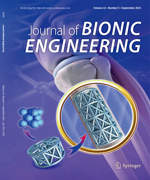Biological musculoskeletal system (MSK), composed of numerous bones, cartilages, skeletal muscles, tendons, ligaments etc., provides form, support, movement and stability for human or animal body. As the result of million years of selection and evolution, the biological MSK evolves to be a nearly perfect mechanical mechanism to support and transport the human or animal body, and would provide enormously rich resources to inspire engineers to innovate new technology and methodology to develop robots and mechanisms as effective and economical as the biological systems. This paper provides a general review of the current status of musculoskeletal biomechanics studies using both experimental and computational methods. This includes the use of the latest three-dimensional motion analysis systems, various medical imaging modalities, and also the advanced rigid-body and continuum mechanics musculoskeletal modelling techniques. Afterwards, several representative biomimetic studies based on ideas and concepts inspired from the structures and biomechanical functions of the biological MSK are dis-cussed. Finally, the major challenges and also the future research directions in musculoskeletal biomechanics and its biomimetic studies are proposed.

 Table of Content
Table of Content
 Table of Content
Table of Content